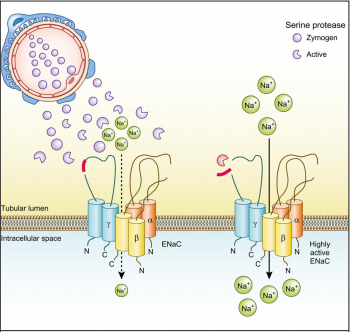The epithelial sodium channel (ENaC) is expressed in the aldosterone-sensitive distal nephron, and it determines the final urinary sodium concentration. To ensure sodium preservation, ENaC-mediated sodium transport is redundantly regulated by several mechanisms. Among them, activation by proteases is a special feature that leads to the removal of inhibitory tracts from the α- and γ-subunits, thus maximizing the channel open probability. Proteolytic ENaC activation by aberrantly filtered proteases or proteasuria has been implicated in the pathogenesis of edema formation and sodium retention in nephrotic syndrome. This concept was strongly supported by the finding that sodium retention in nephrotic mice could be prevented by treatment with either the ENaC blocker amiloride or the serine protease inhibitor aprotinin. In clinical practice, loop diuretics such as furosemide are most commonly used for the antiedematous treatment of patients with nephrotic syndrome. ENaC blockade using amiloride or triamterene could serve as an alternative with better efficacy; however, clinical data are scarce, and ENaC blockade poses the threat of hyperkalemia. This review starts with a case vignette that highlights the therapeutic potential of pharmacological ENaC blockade in treatment-resistant nephrotic edema and continues with discussing the concept of proteolytic ENaC activation in nephrotic syndrome and its therapeutic potential.
Cite this article as: Artunç F. Proteolytic Activation of the Epithelial Sodium Channel in Nephrotic Syndrome by Proteasuria: Concept and Therapeutic Potential. Turk J Nephrol 2020; 29(1): 59-65.

.png)

.png)

.png)

